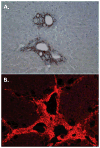The portal fibroblast: not just a poor man's stellate cell
- PMID: 24814904
- PMCID: PMC4090086
- DOI: 10.1053/j.gastro.2014.05.001
The portal fibroblast: not just a poor man's stellate cell
Abstract
Portal fibroblasts, the resident fibroblasts of the portal tract, are found in the mesenchyme surrounding the bile ducts. Their roles in liver homeostasis and response to injury are undefined and controversial. Although portal fibroblasts almost certainly give rise to myofibroblasts during the development of biliary fibrosis, recent lineage tracing studies suggest that their contribution to fibrogenesis is limited compared with that of hepatic stellate cells. Other functions of portal fibroblasts include participation in the peribiliary stem cell niche, regulation of cholangiocyte proliferation, and deposition of specific matrix proteins. Portal fibroblasts synthesize elastin and other components of microfibrils; these may serve structural roles, providing stability to ducts and the vasculature under conditions of increased ductal pressure, or could regulate the bioavailability of the fibrogenic transforming growth factor β in response to injury. Viewing portal fibroblasts in the context of fibroblast populations throughout the body and studying their niche-specific roles in matrix deposition and epithelial regulation could yield new insights into their contributions in the normal and injured liver. Understanding the functions of portal fibroblasts will require us to view them as more than just an alternative to hepatic stellate cells in fibrosis.
Keywords: Bile Duct; Cholangiocyte; Elastic Fiber; Elastin; Hepatic Stellate Cell; Liver Fibrosis; NTPDase 2; Portal Tract.
Copyright © 2014 AGA Institute. Published by Elsevier Inc. All rights reserved.
Conflict of interest statement
No conflicts of interest to disclose
Figures


References
Publication types
MeSH terms
Substances
Grants and funding
LinkOut - more resources
Full Text Sources
Other Literature Sources

